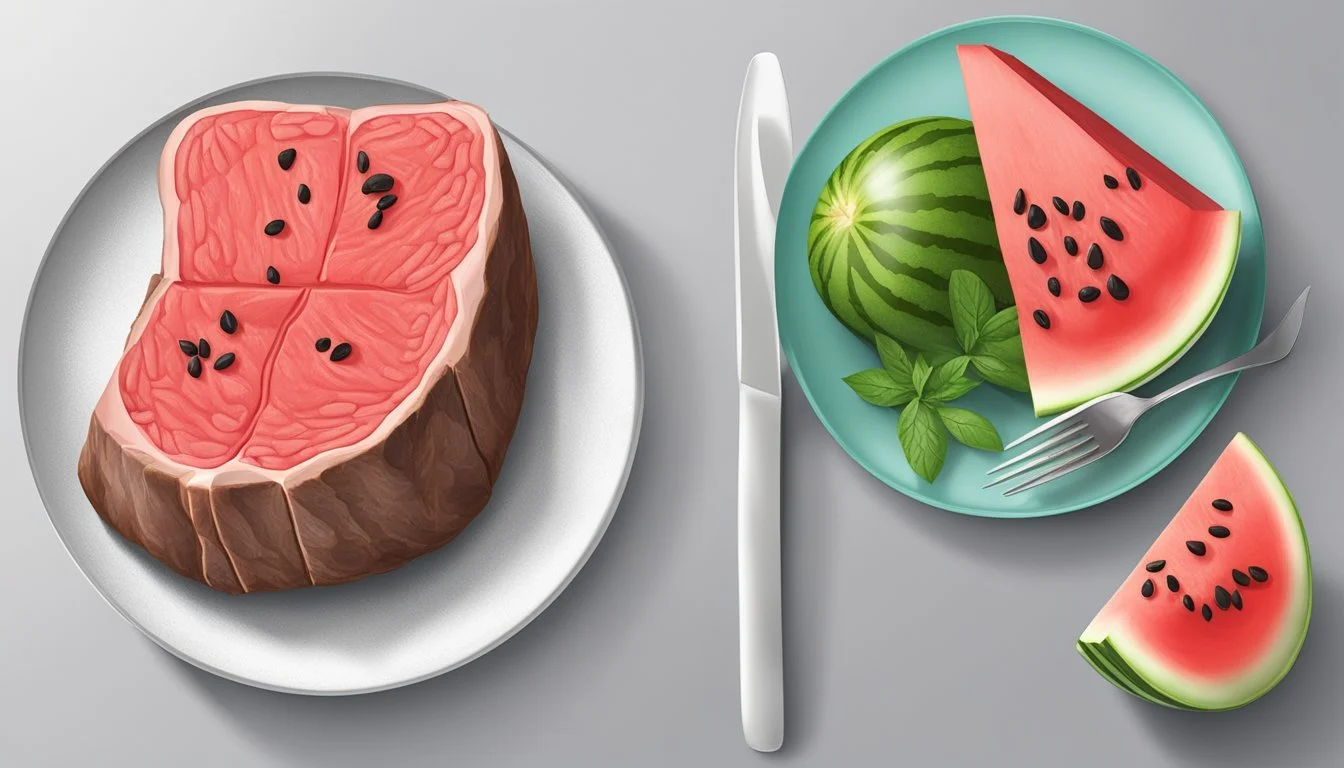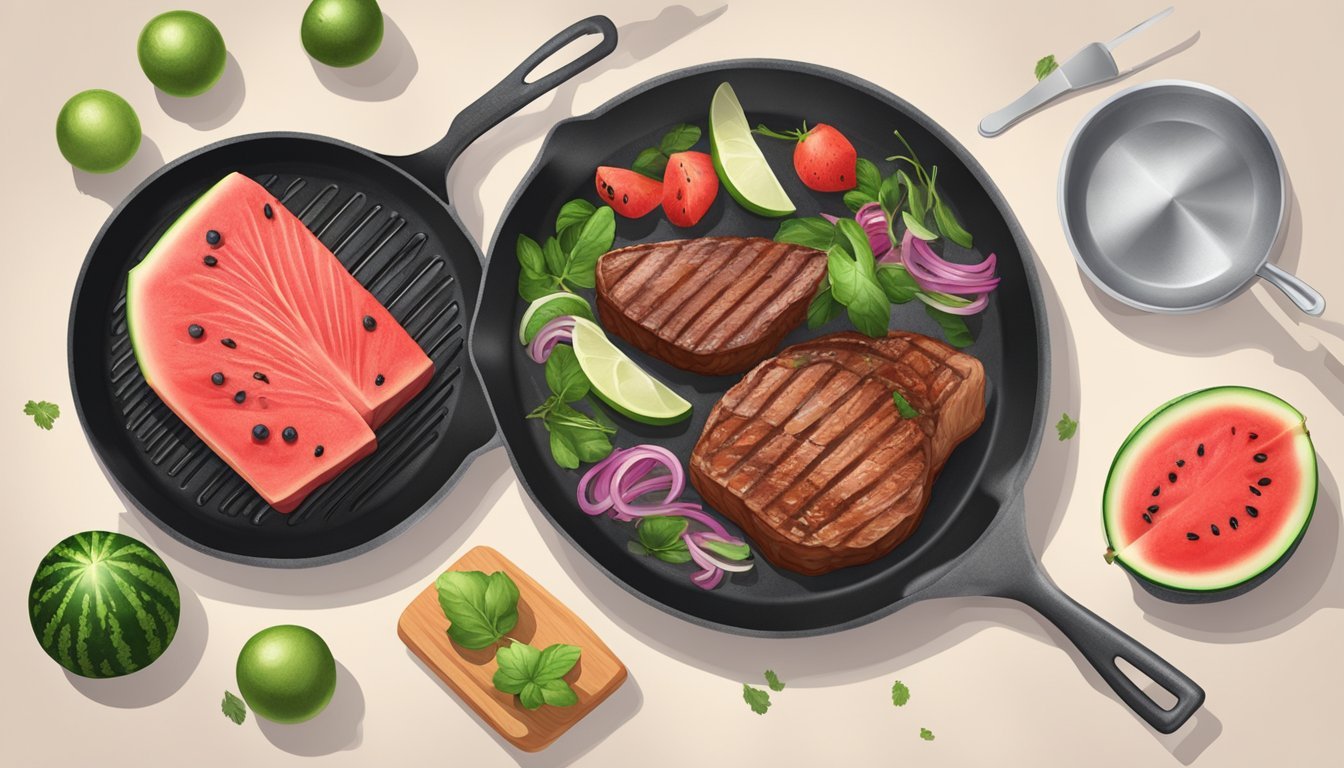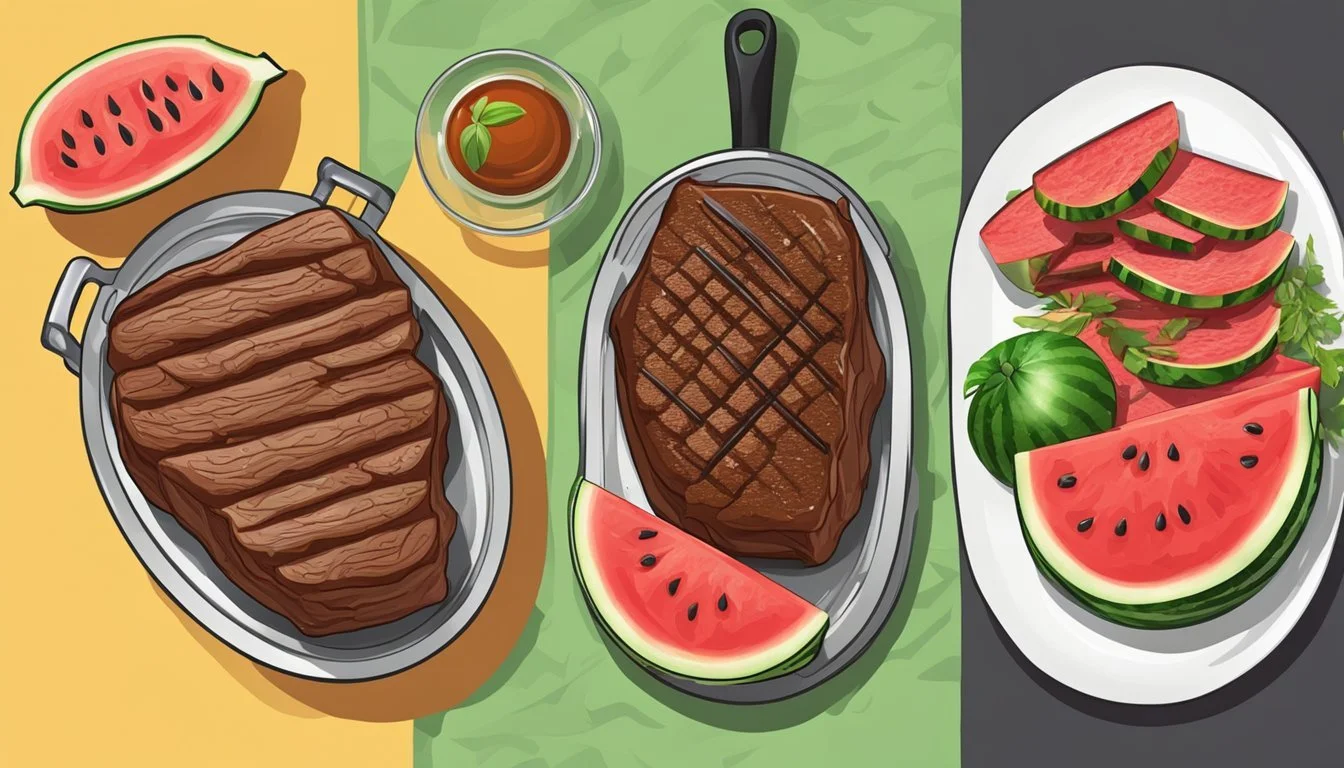Beef vs. Watermelon Steak
Comparing Taste, Nutrition, and Sustainability
Choosing the right steak can make a significant difference for those on a carnivore diet. While beef steak has long been a staple, the curiosity around "watermelon steak" has been growing. Though unconventional, some people experiment with grilling watermelon to resemble steak, which piques interest but doesn't align with carnivore principles. Beef steak offers superior nutritional benefits that are unmatched by watermelon.
Beef is nutritionally dense, providing high levels of protein, essential fats, and numerous vitamins and minerals such as Vitamin B12, which is critical for energy and overall health. A classic cut like ribeye stands out due to its perfect balance of fat and protein, making it a superior choice for anyone following a carnivore diet. In contrast, while grilled watermelon might attain a steak-like appearance, it remains largely water and lacks the substantial nutrients found in beef.
For those prioritizing health and muscle growth on a carnivore diet, beef is undoubtedly the optimal choice. Its nutrient profile supports physiological needs in ways that watermelon simply cannot. This guide aims to further explore the characteristics and benefits of beef steak while touching upon the curiosity surrounding watermelon steak, providing clarity for those looking to make informed dietary decisions. Beef steak's nutritional superiority makes it the clear winner over watermelon steak for those committed to a carnivore lifestyle.
Nutritional Profile Comparison
When deciding between beef and watermelon steak, it's essential to consider their differing nutritional profiles. Beef provides a rich array of vitamins and minerals, whereas watermelon steak offers a high water content with some key nutrients.
Health Benefits of Beef
Beef is a nutrient-dense food that offers several health benefits. It is high in protein, which is essential for muscle repair and growth. A 100g serving of beef provides significant amounts of Vitamin B12, Iron, and Zinc, all crucial for bodily functions.
Vitamins: Contains notable amounts of Vitamin B12 (134% DV) and other B vitamins like B6 and B2. These support energy production and neurological functions.
Minerals: Rich in Iron and Phosphorus, vital for blood health and bone formation.
Protein and Amino Acids: Provides complete proteins with all essential amino acids.
Fat Content: Lean cuts have less fat but still contain healthy monounsaturated fats.
Choosing lean cuts can help balance calorie intake while maximizing nutrient intake.
Exploring Watermelon Steak
Watermelon steak, while unconventional, brings its own set of nutrients to the table. With 91.5 grams of water per 100 grams, it is highly hydrating and low in calories.
Vitamins: Contains Vitamin C and Vitamin A, both important for immune health and vision.
Minerals: Offers Potassium, which helps maintain fluid balance and supports heart health.
Antioxidants: Includes lycopene, which can aid in reducing inflammation and preventing certain types of cancers.
Low Calorie: Ideal for those looking to reduce calorie intake without sacrificing hydration.
Cooking watermelon can result in loss of some water-soluble nutrients, so it’s essential to consider the preparation method.
Culinary Techniques
Various cooking and seasoning methods can significantly impact the flavor and texture of your steak. The choice of technique depends on personal preference and the specific cut of meat.
Steak Preparation and Cooking Styles
When preparing steak, bring it to room temperature before cooking. This ensures even cooking. Cooking techniques vary, with grilling and sous vide being popular choices.
Grilling sears the steak at high heat, creating a flavorful crust.
Sous vide involves vacuum-sealing the steak and cooking it in a water bath at a precise temperature, often resulting in even doneness and tenderness. Cook times vary with thickness; for example, a 1-inch steak may require 1-2 hours.
For those who enjoy a smoky flavor, smoking is an option, though it typically takes longer and requires specific equipment.
Temperature is key to desired doneness. Rare steak is typically cooked to 120-125ºF, medium-rare to 130-135ºF, and well-done to 160ºF and above. Let the steak rest for a few minutes after cooking to retain its juices and enhance flavor.
Seasoning and Marinating
Seasoning enhances the natural flavors of steak. Simple approaches use salt, which draws out moisture, and pepper, creating a basic yet effective seasoning.
For additional flavor, one might use herbs and spices such as rosemary or garlic powder.
Butter can also be added during the resting period to enrich the taste further.
Marinating is another way to infuse flavor. Use a mixture of oil, acid (like vinegar or lemon juice), and seasonings. Keep in mind: marinating times vary depending on the steak's thickness and the desired depth of flavor.
Different cuts respond uniquely to these preparations. Tailoring the techniques to the specific type of steak used can elevate the dining experience.
The Carnivore Diet
The carnivore diet emphasizes consuming animal products exclusively, highlighting nutrient-dense food. Focusing on beef, this guide underscores selecting and incorporating various cuts for nutritional benefits.
Incorporating Different Types of Beef
Beef is a primary component of the carnivore diet due to its nutritional richness. Various cuts like ribeye, sirloin, tenderloin, and ground beef offer different benefits.
Ribeye: Known for its ideal fat-protein balance, ribeye provides essential fats and proteins, supporting muscle mass and energy.
Sirloin: A leaner option with a lower fat content but still rich in proteins.
Tenderloin: Offers a tender texture with a slightly higher fat to protein ratio.
Ground Beef: Versatile and convenient, great for making burgers and meatballs.
Incorporating different cuts ensures a well-rounded intake of nutrients essential for maintaining muscle mass and promoting overall health.
Benefits of Meat-Based Diets
The carnivore diet is praised for its potential benefits. Animal fats and proteins are vital, supplying essential nutrients such as omega-3 fatty acids and vitamins like B12.
Weight loss is a common advantage, attributed to the diet's low-carb nature, which promotes fat burning. Ruminant meats, like beef, are particularly beneficial as they are nutrient-dense and aid in muscle maintenance.
Eating organ meats like liver adds to the nutrient profile, providing a variety of vitamins and minerals often missing in plant-based foods. This diet emphasizes simplicity and nutrient density, which can support general well-being when followed correctly.
Environmental and Ethical Forging
Choosing between beef and alternatives involves considering environmental impact and ethical factors. Beef production, in particular, has significant ecological consequences, while the ethics of meat consumption continue to be a point of debate. Exploring alternatives to beef is also essential in this context.
Environmental Impact of Beef Production
Beef production has one of the highest carbon footprints among food sources. Cows emit significant amounts of methane, a potent greenhouse gas. According to the EWG, a kilo of beef generates 27.1 kilos of CO2. This is more than twice the emissions of pork and almost four times that of chicken.
Additionally, beef production requires vast amounts of water. On average, producing one kilo of beef requires approximately 15,000 liters of water, much of which is used to grow feed crops. Grass-fed beef reduces some impacts but still demands high water and land usage. Furthermore, deforestation for grazing land contributes to biodiversity loss and ecosystem degradation.
Ethical Considerations of Meat Consumption
Animal welfare is a significant ethical concern in meat production. Factory farming practices often involve confined living conditions and inadequate care. This raises questions about the humane treatment of animals raised for food.
The ethical debate also extends to the sustainability of meat consumption. Over-reliance on meat, particularly beef, is unsustainable given the environmental costs. Livestock activities contribute heavily to greenhouse gas emissions, prompting discussions on reducing meat intake for environmental protection.
Consumers are increasingly considering plant-based foods as more ethical alternatives. Vegetables, fruits, grains, and legumes offer lower environmental impacts and avoid animal welfare dilemmas. The ethical implications of meat consumption thus push for a shift toward more sustainable and humane dietary choices.
Alternatives to Beef
Exploring plant-based alternatives can mitigate the environmental and ethical issues tied to beef. Vegetable proteins such as beans, lentils, and tofu offer lower carbon footprints. For example, legumes produce far fewer emissions compared to beef and use less water and land.
Plant-based meats are another growing segment, providing protein-rich options that mimic meat's texture and taste. These products generally have a far smaller environmental impact. Incorporating a variety of grains and other vegetables can complement these proteins, creating a balanced and sustainable diet.
By opting for alternatives, consumers can reduce their ecological footprint and align their diets with ethical practices concerning animal welfare and sustainability. This shift not only benefits the planet but also promotes a healthier approach to nutrition.
Choosing the Right Cut
Selecting the best steak involves considering marbling, tenderness, and flavor preferences. Practical tips on choosing the right beef cut can help you make an informed decision.
Marbling and Tenderness
Marbling refers to the white flecks of fat within the meat. Ribeye steak is well-known for its rich marbling, making it exceptionally tender and juicy.
Filet mignon, while less marbled, offers a very tender texture due to the muscle it comes from. The New York strip balances marbling and tenderness, providing a firm yet tender bite.
The T-bone steak combines the best of both worlds with one side being the tenderloin and the other the strip steak, offering varied textures in one cut.
Flavorful Cuts for Every Palate
Flavor profiles vary significantly across different cuts. Ribeye steak is renowned for its intense beef flavor, largely due to its high marbling content. The New York strip presents a more moderate flavor, ideal for those who prefer a beefy taste without being overwhelmingly rich.
On the other hand, filet mignon provides a milder flavor, which might appeal to those who prefer subtler tastes. Flank steak offers robust and beefy flavors, suitable for marinating and grilling, enhancing its already rich taste.
Practical Tips for Selecting Beef
When choosing beef, always inspect the color — look for a bright, cherry-red hue in raw meat, indicating freshness. Seek out USDA grades such as Prime, Choice, or Select to gauge quality. Ribeye and New York strip steaks from Prime grades usually offer superior marbling and tenderness.
Speak to your local butcher to get personalized recommendations and insights on the best cuts available. Additionally, consider the cooking method you plan to use; for instance, thicker cuts like ribeye are ideal for grilling, while thinner cuts like flank steak are better suited for stir-frying or quick grilling.
Ensuring you select the best cut tailored to your culinary needs will enhance your carnivore dining experience.
Beyond Traditional Steaks
Exploring non-beef options for steaks offers a variety of alternatives to suit different dietary preferences and nutritional needs. From animal-based to plant-based choices like bison, salmon, and watermelon steak, these options provide a unique twist on conventional steak dishes.
Exploration of Non-Beef Options
Non-beef steaks include a variety of proteins that cater to diverse tastes and dietary needs. Bison steak, for example, is known for being leaner than beef and rich in iron. This makes it a suitable choice for those looking for a red meat alternative with a lower fat content.
Salmon steaks provide a rich source of omega-3 fatty acids, essential for heart health. Their unique flavor profile makes them a popular choice for those who prefer seafood. Grilled or baked, salmon steaks are versatile and can be paired with numerous sides for a balanced meal.
Eggs offer another form of protein, especially in dishes where a steak isn't required but a hearty, protein-rich component is desired. While not a steak per se, eggs can complement or even substitute meats in various recipes due to their high protein content and flexibility in cooking methods.
Plant-Based and Vegetable Steaks
With the rise in vegetarian and vegan diets, plant-based steaks offer a significant innovation. Beyond Meat's plant-based steak, for instance, contains 21 grams of protein per serving and significantly less saturated fat compared to traditional beef steaks. This makes it a heart-healthy option for those reducing meat consumption.
Watermelon steak provides a unique vegetable-based alternative. When grilled, watermelon steak mimics the texture of seared meat, making it a visually appealing and refreshing dish. It's an excellent choice for summer barbecues or as a unique addition to a variety of meals.
These plant-based and vegetable options demonstrate that steak lovers don't need to limit themselves to traditional meats. They provide flexibility, catering to dietary preferences, and offering diverse flavors and nutritional benefits.
Cookware and Utensils
Choosing the right cookware and utensils is fundamental for preparing both beef and watermelon steaks.
For a traditional beef steak, a cast iron pan is highly recommended. It provides an excellent sear, retains heat, and is easy to clean.
Grill enthusiasts may opt for a charcoal or gas grill. Both types can achieve a flavorful, smoky char on beef steaks. If using a grill for watermelon steaks, ensure it’s preheated to medium-high heat for the best results.
Sous vide is another method for cooking beef steaks. This technique involves vacuum-sealing the meat and cooking it in a water bath at precise temperatures. After sous vide, a quick sear in a hot pan or grill achieves a perfect crust.
For those interested in smoking meat, a dedicated smoker or a grill set up for indirect cooking works well. This method imparts deep, smoky flavors to beef steaks. Watermelon steaks do not require smoking and should not be prepared this way to maintain their texture and flavor.
When preparing watermelon steaks, grilling is the most effective method. Brush the watermelon slices with a flavorful marinade before grilling to enhance their taste.
Other essential tools include a sharp knife for slicing, tongs for turning steaks on the grill, and a meat thermometer to ensure beef steaks reach the desired internal temperature.
Cutting boards should be used specifically for raw and cooked items to avoid cross-contamination.
Each type of steak, whether beef or watermelon, requires specific cookware and utensils to bring out its best qualities.
Skip the lines and order your tongs, meat thermometer, and cutting board online for a stress-free shopping experience!
Pairings and Complements
The right accompaniments and enhancements can elevate the flavors of your steak, whether traditional beef or watermelon. Selecting suitable side dishes, wines, sauces, and toppings is essential to complement the unique taste of each steak type.
Side Dishes and Wine Pairings
Traditional beef steaks pair well with hearty sides and robust wines. Classic mashed potatoes and roasted vegetables such as asparagus or Brussels sprouts enhance the savory notes of beef. A Cabernet Sauvignon or Malbec can provide a full-bodied complement to the rich flavor and marbling of cuts like ribeye or T-bone.
Conversely, a watermelon steak benefits from lighter, refreshing partners. A watermelon salad with arugula, onions, and a simple olive oil dressing adds a crisp contrast. A Pinot Noir can offer a balanced, lighter flavor that pairs well with the fruitiness of the watermelon and maintains a satisfying dining experience without overpowering the dish.
Sauces and Toppings
For beef steaks, classic sauces such as béarnaise, peppercorn, or a rich ghee butter are popular options. These sauces enhance the meat's natural umami and add a layer of complexity. Toppings like sautéed mushrooms, caramelized onions, and blue cheese crumbles can also provide a pleasing texture and taste contrast.
Watermelon steaks, with their sweet profile, match well with bolder herbs and spices. A balsamic glaze, mint leaves, or a sprinkle of feta cheese works wonderfully. Using herbs like basil or cilantro can introduce an aromatic lift, making the watermelon steak a versatile choice for different palates.
Each combination of sides, wines, sauces, and toppings helps in creating a balanced meal plan that enhances the primary steak choice, catering to both traditional and adventurous tastes.
I always prefer buying ghee and balsamic glaze online because of the added convenience!
Storing and Preserving Steak
Proper storage and preservation methods are crucial to maintain the quality, safety, and taste of steak. These techniques include refrigeration, freezing, dry aging, curing, and making the most of leftovers.
Refrigeration and Freezing
Refrigeration helps keep steak fresh for short-term storage. Raw steak should be stored at temperatures between 34°F and 40°F. Placing it on the lowermost shelf or in a dedicated meat drawer with a plate underneath prevents contamination from run-off juices.
For long-term storage, freezing is essential. Vacuum sealing the steak before freezing ensures minimal air exposure, which helps prevent freezer burn. It’s also useful to label the steak with the date it was frozen to keep track of its freshness.
Dry Aging and Curing
Dry aging enhances steak flavor by allowing natural enzymes to break down muscle fibers. This process requires a controlled environment with temperatures between 34°F and 38°F, adequate air circulation, and humidity control.
Using vacuum-sealed bags can protect against contamination during dry aging. This process typically lasts for 28-40 days. Curing, another preservation method, involves a mix of water, curing salt, and brown sugar. Brining the meat for several weeks can also extend its shelf life while enhancing flavor.
Making the Most of Leftovers
Leftover steak should be stored in an airtight container within two hours of cooking to maintain food safety. When stored in the refrigerator, it can last 3-5 days if kept at or below 40°F.
When reheating, it’s important to do so gently to avoid drying out the meat. Using methods like gentle microwaving, oven reheating at a low temperature, or pan-searing with a splash of broth can retain moisture and flavor. Leftover steak can be a great addition to salads, stir-fries, and wraps, ensuring none of it goes to waste.
By following these methods, one can effectively store and preserve their steak, leading to better taste, safety, and efficient meal planning.
Health Considerations
When comparing beef and watermelon steak, it’s important to look at nutritional needs and potential health impacts. Managing red meat intake is significant for cholesterol and fat levels, while exploring alternative diets can provide benefits from plant-based foods.
Managing Red Meat Intake
Consuming red meat such as beef can be beneficial for nutritional needs, providing essential proteins and fats. Ribeye steak, for example, offers a substantial amount of Vitamin B12, iron, and other nutrients. However, red meat has been linked to higher cholesterol levels, which can affect cardiovascular health.
Moderation is key. Balancing fat intake is crucial, as fatty cuts like ribeye can be energy-dense but lead to increased cholesterol. Opting for leaner cuts or combining red meat with vegetables can help manage these risks.
Exploring Alternative Diets
For those seeking to diversify their diet, incorporating plant-based foods such as watermelon can be an option. Watermelon steak—when cooked—can act as a low-calorie, hydrating alternative. Though it lacks the protein and fat of beef, it provides important vitamins and hydration.
Fruits, vegetables, and grains in a diet contribute to weight loss and overall health. They offer fiber, essential for digestive health, and a variety of micronutrients not found in meat. Exploring plant-based foods can support a balanced diet, mitigating risks associated with high red meat intake.















